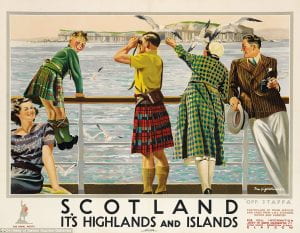Places are defined by people. That seems to be common-sense, a self-evident truism. The place that is currently called ‘Edinburgh’ is, according to this view, ‘made’ by those who live and work and visit there. Although what about those who write about it from a distance, or who turn the place into a character in a film like ‘Trainspotting’?
This poster serves to ‘define’ Scotland as a place.

This place is seagulls, empty seas, lounging smiles and happy men in kilts. The creator of this image has contributed a load of value-ridden codswollop to the definition of the place.
And sticking with Edinburgh, doesn’t my experience of the city that I live in make me knowledgeable in a deeper way about Edinburgh than a person who has always lived in Dover or Eastbourne? If true, this suggests that the people are defined by the landscapes they inhabit.
Tim Ingold in his books, examines the cultural geography of place and space. One axiom is that to be is to know and to know is to be. Just as people define Scotland from what they know, so also do they define themselves from what is experienced by being in the place that is Scotland. Ingold writes about what he calls ‘the dwelling perspective’. Essentially, just as we live actively in a locality, the material existence of that locality impacts on us.
Standing at the edge then, facing the sea, a painter will experience the touch of the wind, the smell of the brine, the sound of the waves, the refracted light. To know this Scottish place is to be – in a very specific ‘Scottish’ way.